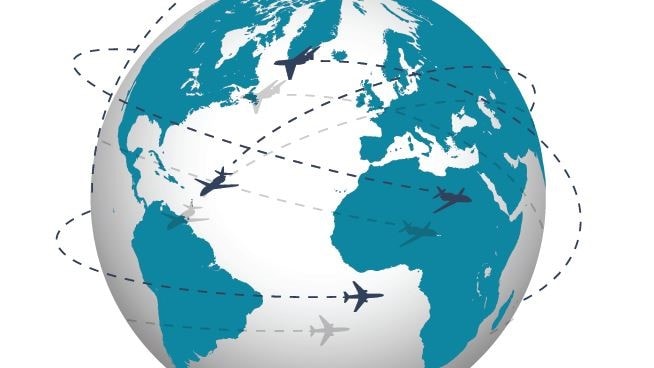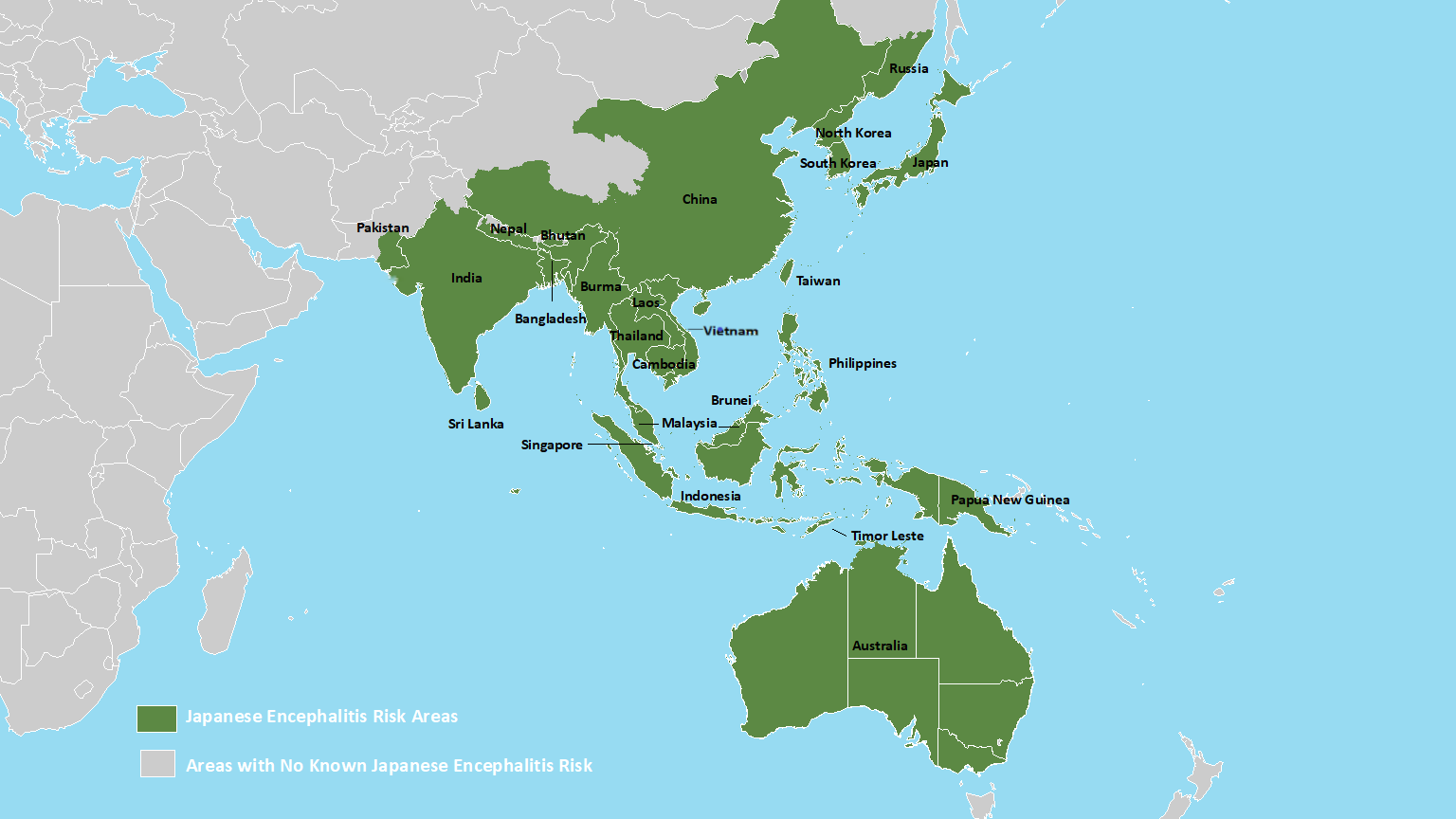Key points
- Japanese encephalitis occurs in Asia and parts of the western Pacific.
- It usually occurs in rural or agricultural areas.

Areas at risk for Japanese encephalitis

Risk areas and transmission season for Japanese encephalitis, by country1,2,3
| Country | Risk areas | Transmission season | Comments |
|---|---|---|---|
| Australia | Outer Torres Strait Islands, Tiwi Islands, and some areas of mainland (parts of New South Wales, Victoria, Queensland, South Australia, and Northern Territory) | November–May | Prior to 1999, 5 cases reported from Outer Torres Strait Islands and Far North Queensland mainland. No further cases reported until 2021. During 2021-2022 cases reported in rural areas of New South Wales, southern Queensland, southeastern South Australia, northern Victoria, and the Top End of the Northern Territory. Key risk locations are in the area surrounding the Murray River, and the Outer Torres Strait islands. |
| Bangladesh | Widespread | Year-round with most cases reported July–November | Highest disease incidence in northwest Bangladesh |
| Bhutan | Presumed widespread in nonmountainous areas | Unknown | Risk likely highest in southern districts that share similar ecologic conditions with bordering JE-endemic states of India |
| Brunei Darussalam | Presumed widespread | Unknown | Limited data but outbreak reported in 2013
Proximity to Sarawak, Malaysia suggests ongoing transmission likely |
| Burma (Myanmar) | Widespread | Year-round with most cases reported May–September | Greatest risk in delta and lowland areas |
| Cambodia | Widespread | Year-round with peak season May–October | Cases reported from majority of provinces, so transmission likely countrywide |
| China | All provinces except Xinjiang and Qinghai | Peak season June–October | |
| India | Andhra Pradesh, Arunachal Pradesh, Assam, Bihar, Goa, Haryana, Jharkhand, Karnataka, Kerala, Maharashtra, Manipur, Meghalaya, Nagaland, Odisha, Punjab, Tamil Nadu, Telangana, Tripura, Uttar Pradesh, Uttarakhand, West Bengal | Peak season May–November, especially in northern India; the season may be extended or year-round in some areas, especially in southern India | |
| Indonesia | Widespread | Year-round, with peak season varying by island | Cases reported from many islands, including Sumatra, Java, Kalimantan, Bali, Nusa Tenggara, and Papua, so transmission likely on all islands
Several traveler cases reported in recent years from Bali |
| Japan | All islands | June–October | Rare sporadic cases reported from all islands except Hokkaido
Enzootic transmission without reported human cases on Hokkaido |
| Lao People’s Democratic Republic | Widespread | Year-round with peak season June–September | |
| Malaysia | Widespread | Year-round, with peak season in Sarawak from October–December | Much higher rates of disease reported from Sarawak than peninsular Malaysia |
| Nepal | Southern lowlands (Terai), some hill and mountain districts | Peak season June–October | Highest rates of disease reported from southern lowlands (Terai)
Vaccine not routinely recommended for those trekking in high-altitude areas |
| North Korea | Presumed widespread | Unknown
Proximity to South Korea suggests peak transmission May–November |
|
| Pakistan | Unknown | Unknown | Very limited data
Previous case report and serosurvey data suggest transmission possible at least in Sindh Province |
| Papua New Guinea | Widespread | Presumed year-round | Sporadic cases reported from Western Province, serologic evidence of disease from Gulf and Southern Highland Provinces, and 1 case reported from near Port Moresby, so transmission likely countrywide |
| Philippines | Widespread | Year-round with peak season April–August | Human, animal, and mosquito studies have indicated transmission in 32 provinces, and transmission likely on all islands |
| Russia | Primorsky Krai | June–September | Cases previously reported from Primorsky Krai
Vaccine not routinely recommended |
| Singapore | Presumed in focal areas | Year-round | Very rare sporadic cases reported
Vaccine not routinely recommended |
| South Korea | Widespread | May–November | |
| Sri Lanka | Widespread except in mountainous areas | Year-round with peak season November–February | |
| Taiwan | Widespread | Peak season May–October | |
| Thailand | Widespread | Year-round with peak season May–October, especially in northern Thailand | Highest rates of disease reported from Chiang Mai Valley
Several traveler cases reported in recent years from resort and coastal areas of southern Thailand |
| Timor-Leste | Presumed widespread | No data
Proximity to West Timor suggests year-round |
|
| Vietnam | Widespread | Year-round with peak season May–October, especially in northern Viet Nam |
1 Destination and transmission season information should be considered in association with travel duration and activities when making decisions on vaccination.
2 Data are based on published and unpublished reports. Risk assessments should be performed cautiously, because risk can vary within areas and from year to year, and surveillance data regarding human cases and Japanese encephalitis virus transmission are often incomplete. In some endemic areas, human cases among residents are limited because of vaccination or natural immunity among older people. However, because Japanese encephalitis virus is maintained in an enzootic cycle between animals and mosquitoes, susceptible visitors to these areas still may be at risk for infection.
3 Outbreaks previously occurred in the Western Pacific Islands of Guam (1947–1948) and Saipan (1990), but as they are no longer considered risk areas, they are not included in the table.
